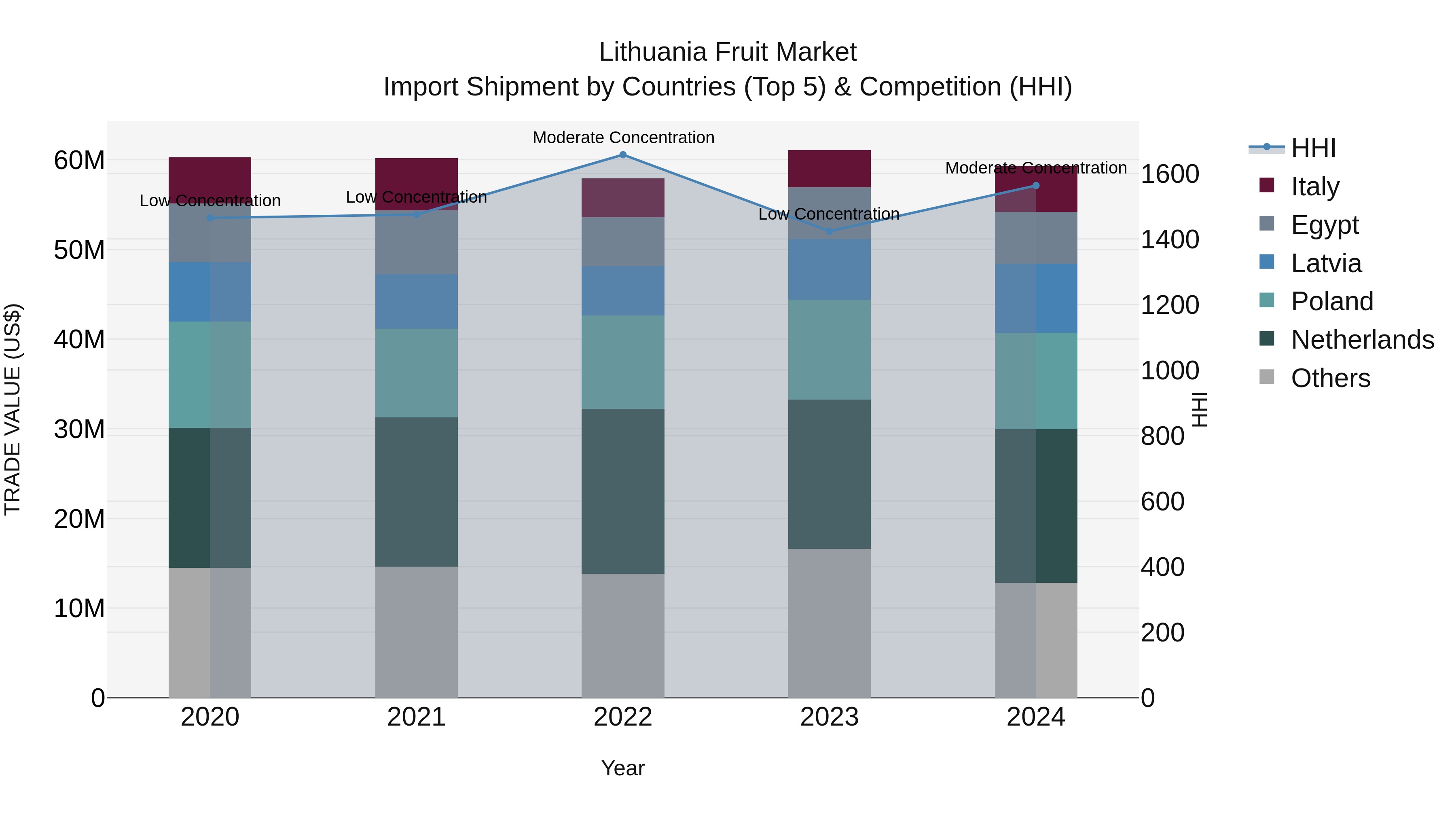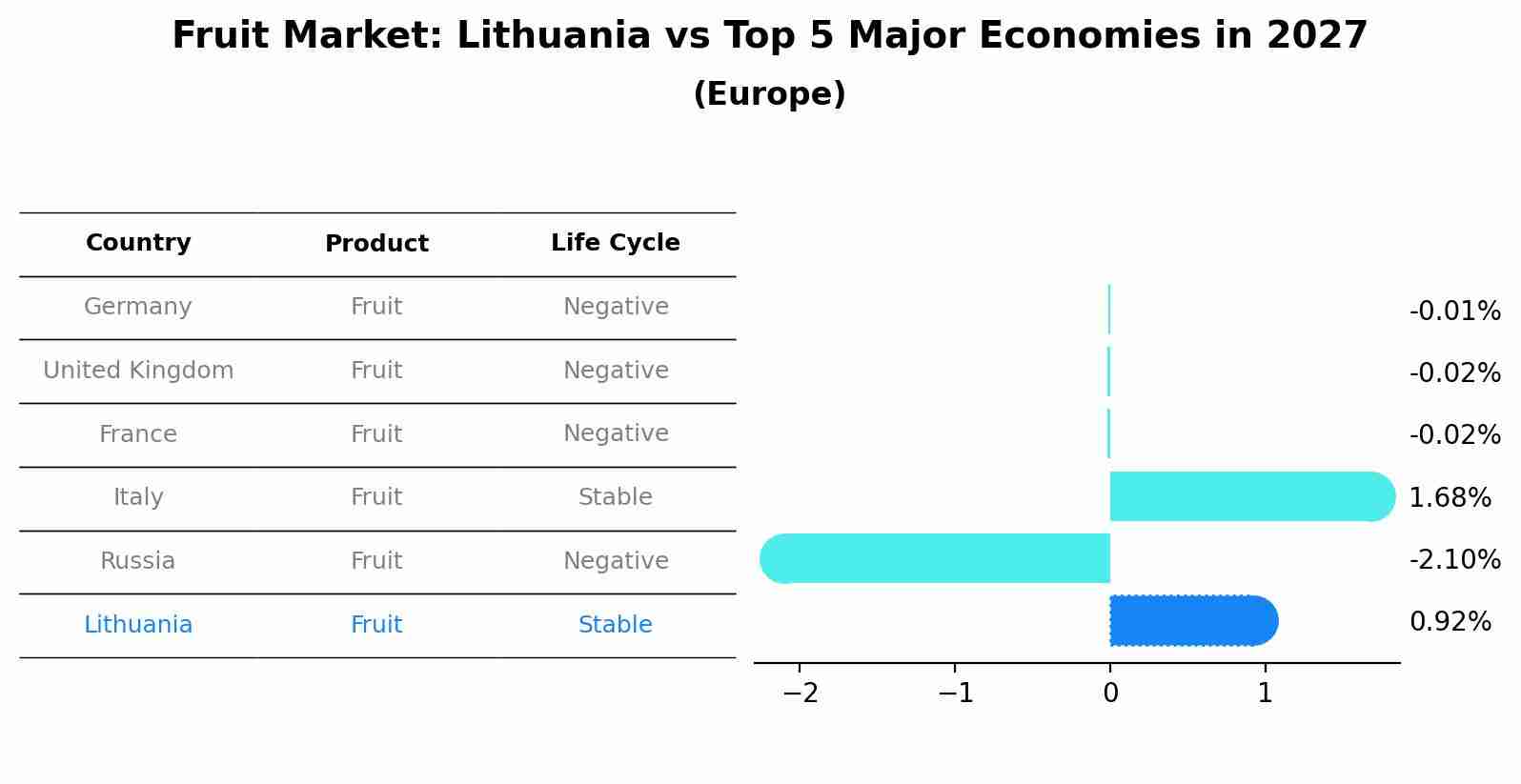Lithuania Fruit Market (2025-2031) | Trends, Companies, Revenue, Share, Segmentation, Value, Size, Outlook, Forecast, Growth, Analysis & Industry
| Product Code: ETC4946595 | Publication Date: Nov 2023 | Updated Date: Nov 2025 | Product Type: Market Research Report | |
| Publisher: 6Wresearch | Author: Shubham Padhi | No. of Pages: 60 | No. of Figures: 30 | No. of Tables: 5 |
Lithuania Fruit Market Top 5 Importing Countries and Market Competition (HHI) Analysis
Lithuania`s fruit import market saw a shift in concentration from low to moderate in 2024, with the top exporting countries being Netherlands, Poland, Latvia, Egypt, and Italy. Despite a negative compound annual growth rate (CAGR) of -0.43% from 2020 to 2024, the market experienced a further decline in growth rate of -2.95% from 2023 to 2024. This indicates a challenging landscape for fruit importers in Lithuania, possibly influenced by changing consumer preferences or external factors affecting trade dynamics. Monitoring these trends closely will be crucial for stakeholders navigating the evolving market conditions.

Fruit Market: Lithuania vs Top 5 Major Economies in 2027 (Europe)
In the Europe region, the Fruit market in Lithuania is projected to expand at a stable growth rate of 0.92% by 2027. The largest economy is Germany, followed by United Kingdom, France, Italy and Russia.

Key Highlights of the Report:
- Lithuania Fruit Market Outlook
- Market Size of Lithuania Fruit Market, 2024
- Forecast of Lithuania Fruit Market, 2031
- Historical Data and Forecast of Lithuania Fruit Revenues & Volume for the Period 2021-2031
- Lithuania Fruit Market Trend Evolution
- Lithuania Fruit Market Drivers and Challenges
- Lithuania Fruit Price Trends
- Lithuania Fruit Porter`s Five Forces
- Lithuania Fruit Industry Life Cycle
- Historical Data and Forecast of Lithuania Fruit Market Revenues & Volume By Applications for the Period 2021-2031
- Historical Data and Forecast of Lithuania Fruit Market Revenues & Volume By Supermarkets and Hypermarkets for the Period 2021-2031
- Historical Data and Forecast of Lithuania Fruit Market Revenues & Volume By Specialty Stores for the Period 2021-2031
- Historical Data and Forecast of Lithuania Fruit Market Revenues & Volume By Online for the Period 2021-2031
- Historical Data and Forecast of Lithuania Fruit Market Revenues & Volume By Type for the Period 2021-2031
- Historical Data and Forecast of Lithuania Fruit Market Revenues & Volume By Fresh for the Period 2021-2031
- Historical Data and Forecast of Lithuania Fruit Market Revenues & Volume By Dried for the Period 2021-2031
- Historical Data and Forecast of Lithuania Fruit Market Revenues & Volume By Frozen for the Period 2021-2031
- Historical Data and Forecast of Lithuania Fruit Market Revenues & Volume By Others for the Period 2021-2031
- Lithuania Fruit Import Export Trade Statistics
- Market Opportunity Assessment By Applications
- Market Opportunity Assessment By Type
- Lithuania Fruit Top Companies Market Share
- Lithuania Fruit Competitive Benchmarking By Technical and Operational Parameters
- Lithuania Fruit Company Profiles
- Lithuania Fruit Key Strategic Recommendations
Frequently Asked Questions About the Market Study (FAQs):
1 Executive Summary |
2 Introduction |
2.1 Key Highlights of the Report |
2.2 Report Description |
2.3 Market Scope & Segmentation |
2.4 Research Methodology |
2.5 Assumptions |
3 Lithuania Fruit Market Overview |
3.1 Lithuania Country Macro Economic Indicators |
3.2 Lithuania Fruit Market Revenues & Volume, 2021 & 2031F |
3.3 Lithuania Fruit Market - Industry Life Cycle |
3.4 Lithuania Fruit Market - Porter's Five Forces |
3.5 Lithuania Fruit Market Revenues & Volume Share, By Applications, 2021 & 2031F |
3.6 Lithuania Fruit Market Revenues & Volume Share, By Type, 2021 & 2031F |
4 Lithuania Fruit Market Dynamics |
4.1 Impact Analysis |
4.2 Market Drivers |
4.2.1 Increasing demand for organic and healthy food products |
4.2.2 Growing awareness about the health benefits of consuming fruits |
4.2.3 Government initiatives to promote local agriculture and fruit production |
4.3 Market Restraints |
4.3.1 Seasonal fluctuations impacting fruit availability and pricing |
4.3.2 Competition from imported fruits in the market |
5 Lithuania Fruit Market Trends |
6 Lithuania Fruit Market Segmentations |
6.1 Lithuania Fruit Market, By Applications |
6.1.1 Overview and Analysis |
6.1.2 Lithuania Fruit Market Revenues & Volume, By Supermarkets and Hypermarkets, 2021-2031F |
6.1.3 Lithuania Fruit Market Revenues & Volume, By Specialty Stores, 2021-2031F |
6.1.4 Lithuania Fruit Market Revenues & Volume, By Online, 2021-2031F |
6.2 Lithuania Fruit Market, By Type |
6.2.1 Overview and Analysis |
6.2.2 Lithuania Fruit Market Revenues & Volume, By Fresh, 2021-2031F |
6.2.3 Lithuania Fruit Market Revenues & Volume, By Dried, 2021-2031F |
6.2.4 Lithuania Fruit Market Revenues & Volume, By Frozen, 2021-2031F |
6.2.5 Lithuania Fruit Market Revenues & Volume, By Others, 2021-2031F |
7 Lithuania Fruit Market Import-Export Trade Statistics |
7.1 Lithuania Fruit Market Export to Major Countries |
7.2 Lithuania Fruit Market Imports from Major Countries |
8 Lithuania Fruit Market Key Performance Indicators |
8.1 Average selling price of fruits in Lithuania |
8.2 Number of new fruit products introduced in the market |
8.3 Consumer spending on fruits as a percentage of total food expenditure |
9 Lithuania Fruit Market - Opportunity Assessment |
9.1 Lithuania Fruit Market Opportunity Assessment, By Applications, 2021 & 2031F |
9.2 Lithuania Fruit Market Opportunity Assessment, By Type, 2021 & 2031F |
10 Lithuania Fruit Market - Competitive Landscape |
10.1 Lithuania Fruit Market Revenue Share, By Companies, 2024 |
10.2 Lithuania Fruit Market Competitive Benchmarking, By Operating and Technical Parameters |
11 Company Profiles |
12 Recommendations | 13 Disclaimer |
- Single User License$ 1,995
- Department License$ 2,400
- Site License$ 3,120
- Global License$ 3,795
Search
Thought Leadership and Analyst Meet
Our Clients
Related Reports
- Canada Oil and Gas Market (2026-2032) | Share, Segmentation, Value, Industry, Trends, Forecast, Analysis, Size & Revenue, Growth, Competitive Landscape, Outlook, Companies
- Germany Breakfast Food Market (2026-2032) | Industry, Share, Growth, Size, Companies, Value, Analysis, Revenue, Trends, Forecast & Outlook
- Australia Briquette Market (2025-2031) | Growth, Size, Revenue, Forecast, Analysis, Trends, Value, Share, Industry & Companies
- Vietnam System Integrator Market (2025-2031) | Size, Companies, Analysis, Industry, Value, Forecast, Growth, Trends, Revenue & Share
- ASEAN and Thailand Brain Health Supplements Market (2025-2031) | Strategy, Consumer Insights, Analysis, Investment Trends, Opportunities, Growth, Size, Share, Industry, Revenue, Segments, Value, Segmentation, Supply, Forecast, Restraints, Outlook, Competition, Drivers, Trends, Demand, Pricing Analysis, Competitive, Strategic Insights, Companies, Challenges
- ASEAN Bearings Market (2025-2031) | Strategy, Consumer Insights, Analysis, Investment Trends, Opportunities, Growth, Size, Share, Industry, Revenue, Segments, Value, Segmentation, Supply, Forecast, Restraints, Outlook, Competition, Drivers, Trends, Demand, Pricing Analysis, Competitive, Strategic Insights, Companies, Challenges
- Europe Flooring Market (2025-2031) | Outlook, Share, Industry, Trends, Forecast, Companies, Revenue, Size, Analysis, Growth & Value
- Saudi Arabia Manlift Market (2025-2031) | Outlook, Size, Growth, Trends, Companies, Industry, Revenue, Value, Share, Forecast & Analysis
- Uganda Excavator, Crane, and Wheel Loaders Market (2025-2031) | Strategy, Consumer Insights, Analysis, Investment Trends, Opportunities, Growth, Size, Share, Industry, Revenue, Segments, Value, Segmentation, Supply, Forecast, Restraints, Outlook, Competition, Drivers, Trends, Demand, Pricing Analysis, Competitive, Strategic Insights, Companies, Challenges
- Rwanda Excavator, Crane, and Wheel Loaders Market (2025-2031) | Strategy, Consumer Insights, Analysis, Investment Trends, Opportunities, Growth, Size, Share, Industry, Revenue, Segments, Value, Segmentation, Supply, Forecast, Restraints, Outlook, Competition, Drivers, Trends, Demand, Pricing Analysis, Competitive, Strategic Insights, Companies, Challenges
Industry Events and Analyst Meet
Whitepaper
- Middle East & Africa Commercial Security Market Click here to view more.
- Middle East & Africa Fire Safety Systems & Equipment Market Click here to view more.
- GCC Drone Market Click here to view more.
- Middle East Lighting Fixture Market Click here to view more.
- GCC Physical & Perimeter Security Market Click here to view more.
6WResearch In News
- Doha a strategic location for EV manufacturing hub: IPA Qatar
- Demand for luxury TVs surging in the GCC, says Samsung
- Empowering Growth: The Thriving Journey of Bangladesh’s Cable Industry
- Demand for luxury TVs surging in the GCC, says Samsung
- Video call with a traditional healer? Once unthinkable, it’s now common in South Africa
- Intelligent Buildings To Smooth GCC’s Path To Net Zero


















